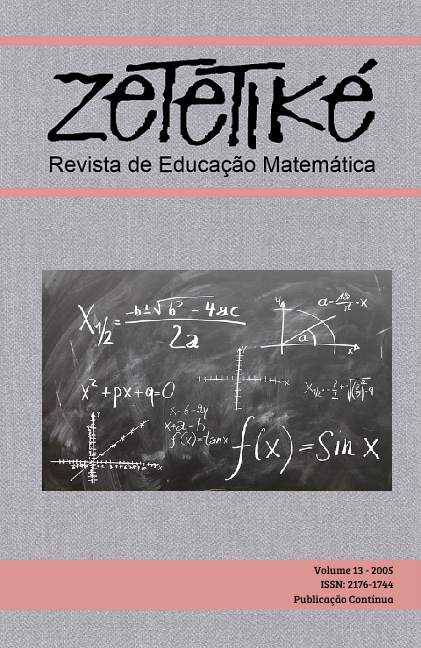Resumo
Este artigo relata uma pesquisa — realizada numa escola de ensino fundamental — que investigou a dimensão tácito-explícita da aprendizagem matemática, e consistiu de dois estudos seqüenciais. No primeiro deles, analisamos um episódio relacionado a uma discussão — promovida pela professora, em sala de aula — acerca da diferença entre figuras planas e figuras espaciais. No segundo estudo, foi observado o desenvolvimento do conhecimento matemático de áreas e medidas de uma dupla de alunos. Os dados foram analisados com base em alguns aspectos da teoria de Polanyi sobre conhecimento tácito e no modelo de Ernest do conhecimento matemático, segundo seus componentes principalmente tácitos e principalmente explícitos. Dentre os resultados de pesquisa, obtivemos uma forte indicação de que a cognição não é, necessariamente, restrita e coincidente com a linguagem, mas vista como uma prática social situada, movendo-se entre os pólos das dimensões tácita da ação eficaz e explícita, projeção intersubjetiva dessa ação.
Referências
BOALER, J. Exploring the Nature of Mathematical Activity: Using theory, Research and ‘Working Hypotheses’ to Broaden Conceptions of Mathematics Knowing. Educational Studies in Mathematics, v51, n1-2, 3-21, 2002.
ERNEST, P. Social Construtivism as a Philosophy of Mathematics. Albany: SUNY, 1998a.
ERNEST, P. Mathematical Knowledge and Context, Situated Cognition and the Learning of Mathematics. In A. Watson (org.), Oxford: University of Oxford Department of Educational Studies, 13-29, 1998b.
FISCHBEIN, E. Tacit Models and Mathematical Reasoning. For the Learning of Mathematics (9)2, 9-14, 1989.
FRADE, C.; BORGES, O. Tacit Knowledge in Curricular Goals in Mathematics. In Proceedings of the 2nd International Conference on the Teaching of Mathematics (at the undergraduate level), Hersonissos, Greece, 1-6 July, 2002.
FRADE, C. Componentes Tácitos e Explícitos do Conhecimento Matemático de Áreas e Medidas. Tese de Doutorado não publicada. Faculdade de EducaçãoUFMG, 251 páginas, 2003.
HIEBERT, J.; LEFEVRE, P. Conceptual and Procedural Knowledge in Mathematics: An Introductory Analysis. In J. Hiebert (org.), Hillsdale (NJ), Chapter 1, 1-27, 1986.
IMENES, L. M.; LELLIS, M. Matemática, 6ª série. São Paulo: Scipione, 1997.
LERMAN, S. Getting used to mathematics: alternative ways of speaking about becoming mathematical. Ways of Knowing, 1(1), 47-52, 2001.
MELLIN-OLSEN, S. Instrumentalism as an Educational Concept, Educational Studies in Mathematics, Vol. 12, 351-367, 1981.
POLANYI, M. Personal Knowledge. London: Routledge & Kegan Paul, 1962.
POLANYI, M. Knowing and Being. Ed. by M. Grene. Chicago: Chicago University Press, 1969.
POLANYI, M. The Tacit Dimension. Gloucester (Mass): Peter Smith, 1983.
SKEMP, R. R. Relational understanding and instrumental understanding. Mathematics Teaching, n77, 20-26, 1976.
STERNBERG, R. J. Theory and Measurement of Tacit Knowledge as a Part of Practical Intelligence. Zeitschrift für Psychologie, 203, 319-334, 1995.
STROM, D.; KEMENY, V.; LEHRER, R.; FORMAN, E. Visualizing the emergent structure of children’s mathematical argument. Cognitive Science. 25, 733-773, 2001.
TIROSH, D., Ed. Implicit and Explicit Knowledge: An Educational Approach, Norwood (NJ): Ablex Publishing Co, 1994.
WENGER, E. Communities of Practice: Learning, Meaning and Identity. Cambridge: UK, Cambridge University Press, 1998.
WIGNER, E.P; HODGKIN, R.A. "Michael Polanyi" in Biographical Memoirs of Fellows of the Royal Society, v23, London: The Royal Society, Nov. 1977: 413- 438, 1997.

Este trabalho está licenciado sob uma licença Creative Commons Attribution-NonCommercial-NoDerivatives 4.0 International License.
Copyright (c) 2014 Zetetiké: Revista de Educação Matemática

